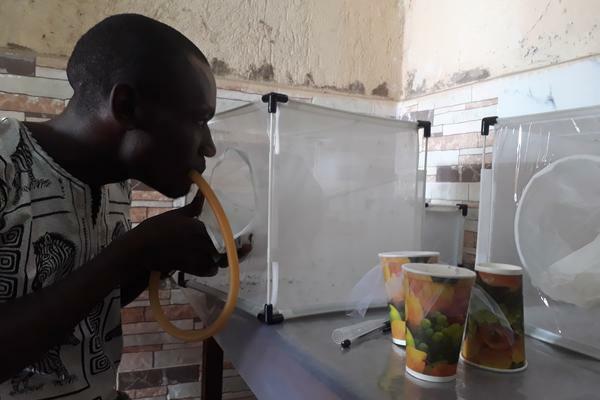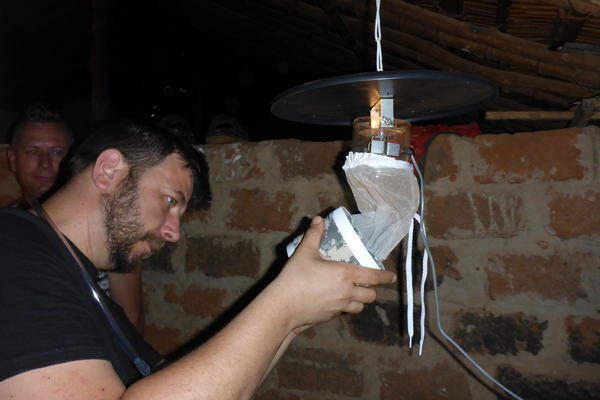
Deployment of new combination insecticidal bednets in Africa to combat pyrethroid resistance in malaria mosquitoes
Malaria prevention in Africa is dependent on Insecticide Treated Nets (ITNs) which prevented 500 million malaria cases from 2000-2015.
However, until 2017, all insecticides used in ITNs were pyrethroids and LSTM’s research has highlighted the public health threat from pyrethroid resistance.
LSTM has pioneered research into the causes, consequences and rapid spread of pyrethroid resistance in African malaria vectors and provided practical solutions to combat the problem. The outputs of this research, which span the translational pipeline, have alerted international agencies to the problem, defined the scale and complexity of the issue, informed the development of new classes of insecticides and next-generation ITNs using insecticide or insecticide/synergist combinations, and informed national and global policy on when, and where, the new products should be deployed for maximum public health impact.
Designing new approaches for resistance monitoring, LSTM has evaluated alternative bioassays; these have been incorporated into WHO guidelines (2016) and discussions are ongoing on the incorporation of alternative assays for new insecticides. These measures have strengthened resistance monitoring and helped operational decision-making.

Understanding the genetics and behaviour of mosquitoes has been key in understanding and combatting insecticide resistance and has been pivotal in the development of mitigating strategies. Our work on pyrethroid resistance mechanisms has led to several new classes of ITNs, including PBO-pyrethroid nets that are now being included in many national net distribution schemes across Africa, whereas our studies on mosquito behaviour have led the development and field testing of nets that can utilise insecticides previously discounted from the use on nets, given their cost or toxicity. We also play a major role in the evaluation of new classes of ITNs and are currently leading the entomological evaluation of the largest ever trial of a vector control tool, a trial of PBO-pyrethroid ITNs in Uganda.

Research Outputs
Barnes KG, Weedall GD, Ndula M, Irving H, Mzihalowa T, Hemingway J, Wondji CS. 2017. Genomic Footprints of Selective Sweeps from Metabolic Resistance to Pyrethroids in African Malaria Vectors Are Driven by Scale-up of Insecticide-Based Vector Control.PLoS Genet 13: e1006539.
Implications of insecticide resistance for malaria vector control with long-lasting insecticidal nets: a WHO-coordinated, prospective, international, observational cohort study. Lancet Infect Dis. 2018 Jun; 18(6): 640–649. doi: 10.1016/S1473-3099(18)30172-5
Churcher TS, Lissenden N, Griffin JT, Worrall E, Ranson H. 2016. The impact of pyrethroid resistance on the efficacy and effectiveness of bednets for malaria control in Africa. Elife 5.
Tiono AB, Ouédraogo A, Ouattara D, Bougouma EC, Coulibaly S, Diarra A, Faragher B, Guelbeogo Page 11 of 37 et al, Ranson H, Lindsay SW. Efficacy of Olyset Duo, a bednet containing pyriproxyfen and permethrin, versus a permethrin-only net against clinical malaria in an area with highly pyrethroid resistant vectors in rural Burkina Faso: a cluster-randomised controlled trial. Lancet. 2018 Aug 18;392(10147):569-580. PMID:30104047
GPD Murray, N Lissenden, J Jones, V Voloshin, KH Toé, E Sherrard-Smith, GM Foster, TS Churcher, JEA Parker, CE Towers, WM Guelbeogo, Sagnon N’Falé, H. Ranson, D. Towers, P. J. McCall. Barrier bednets target malaria vectors and expand the range of usable insecticides. Nature Microbiology,5, 40–47 (2020). https://doi.org/10.1038/s41564-019-0607-2
Reducing Malaria Prevalence in Africa Through New Classes of Insecticide-Treated Nets
Widespread use of insecticide treated nets (ITNs) has dramatically reduced the incidence of malaria in Africa but resistance to pyrethroid insecticides in Anopheles mosquitoes is eroding their efficacy.
In this seminar LSTM Professor Hilary Ranson, Professor Martin Donnelly, Professor Philip McCall, Dr David Weetman and Dr Gareth Lycett highlight how research from the Department of Vector Biology at LSTM on the mechanisms underpinning pyrethroid resistance, and the behavioural response of mosquitoes to ITNS has led to the development of new classes on ITNs mosquitoes.They will highlight how, by working in partnership with different sectors we have developed the evidence base for the public health value of these nets that has led to their widespread deployment across Africa to combat resistant mosquito populations.
ESSENTIALs
The ESSENTIALs project is the latest programme led ny the Vector Biology Department, developing, performing and evaluating new entomological assays to determine the performance of new classes of nets against different mosquito populations across Africa.
ESSENTIALs will determinine whether a combination of entomological monitoring and mathematical modelling, could be used to predict the efficacy of future new classes of ITNs without the need for lengthy and costly clinical trials.

Partnership for Increasing the Impact of Vector Control
Supported by long term mentorship from LSTM and rigorous evaluation of the capacity needs in-country, this partnership will generate new knowledge and tools, strengthen research capacity, and reinforce links between researchers and policy-makers, leading to reduced disease burden and increased resilience for responding to outbreaks.





















